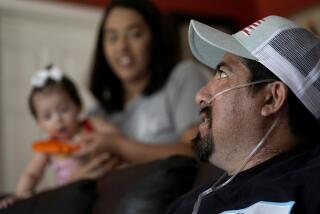Schroeder Reported ‘Weak, Tired’ : Haydon ‘Fantastic’ a Day After His Heart Implant
- Share via
LOUISVILLE, Ky. — Third artificial heart recipient Murray P. Haydon, giving the thumbs-up sign to his doctors and family on Monday, “looked fantastic” a day after surgery and his condition was “so good that it’s frightening,” one of his doctors said.
But on the same floor, William J. Schroeder, while looking somewhat better Monday, has been “weak, tired and discouraged” from a mysterious fever that has raised doubts that he will ever permanently leave the hospital.
The world’s two living man-made heart recipients made for an unusual contrast at Humana Hospital Audubon--bright optimism about Haydon’s smooth beginning to a new life and the bleakest picture yet of Schroeder, an 86-day veteran of the heart whose illness and sagging spirits could be life-threatening if they persist.
“We are doing everything we can to try to give Mr. Schroeder some encouragement, but if he does not get stronger and get over his fever, then he will remain discouraged and that would be a threat to his life,” said Dr. Allan M. Lansing, medical director of Humana Heart Institute International.
But later in the day, after visiting Schroeder again, Lansing said that the patient was stronger and looked brighter. “He is a very sick man, but the course over the last few days has been one of improvement,” the surgeon said.
The spirits of Haydon, a 58-year-old retired auto worker from Louisville, were excellent after the 3 1/2-hour surgery Sunday to implant the Jarvik-7 heart. Although he remained in intensive care, his vital signs were stable. The respirator was removed and he was breathing on his own.
“We could not ask for a better situation,” Lansing said, joking that Haydon’s condition “is so good that it’s frightening, and makes us concerned that some catastrophe is waiting.”
The rate of the Jarvik-7 heart, powered by regular bursts of compressed air from the 323-pound Utahdrive machine, was increased from 50 to 60 beats a minute.
During the implant, which surgeon William C. DeVries said seemed “almost routine,” Haydon’s diseased heart was removed and Dacron cuffs were sewed on to the major vessels leading to and from the heart chambers. Each half of the plastic-and-metal heart was then placed in the chest cavity and snapped on to the cuffs.
Haydon has shown no signs of bleeding, a problem that had hampered Schroeder’s recovery, and he was being given drugs to thin his blood and prevent clots, which can cause strokes.
Doctors continued to worry, though, about Schroeder’s condition, and the prognosis was guarded. “It could go either way depending entirely on disappearance of his fever and return of his spirits and strength,” Lansing said.
Had Been Growing Stronger
Despite a series of strokes two months ago that left Schroeder’s speech and memory impaired, he had been growing stronger and had hoped to leave the hospital by Valentine’s Day, his 53rd birthday.
But in late January, he developed an unusual fever, which rose above normal only once a day. It persisted, sapping his strength and making him depressed.
“He was on the verge of leaving the hospital and that door was shut in his face,” Lansing said.
Doctors have been unable to find an obvious cause for the fever, which continues, although the degree to which it rises has been decreasing. But Lansing said that he is “95% sure” that the fever is a side effect of Dilantin, a medication given to control seizures. Schroeder suffered three or four very mild seizures--episodes during which he “stared out into space” for periods lasting from five minutes to a half-hour, Lansing said.
Known Side Effect
Fevers are a rare but known side effect of Dilantin. The drug was begun on Jan. 3 and stopped Feb. 1. It was administered again on Feb. 5 and stopped Feb. 7. Another drug has replaced it.
The fever should have disappeared by now, Lansing said. However, a secondary effect of the drug can be to lower the white blood count, making the patient susceptible to a viral infection.
If that is what is causing the fever, Lansing said, “as his white blood count comes up to normal, we would expect that to be overcome.”
The stroke and now the fever are “very disappointing. It’s a rough thing to have happen,” said Dr. Robert K. Jarvik, inventor of the heart used in all three recipients. He has spent hours with Margaret Schroeder and her husband in the last week.
Ride in Van Planned
Lansing said that Schroeder’s current “discouragement” was probably related to unhappiness over the setback and not getting out of the hospital. If the “upward trend” of Schroeder’s condition continues, Lansing said, the hospital staff plans to take Schroeder for a ride in a van being specially equipped for artificial heart patients.
“That will be such a positive medicine that it may be hard to hold him down again,” he said.
Lansing said that the psychiatrist treating Schroeder, Dr. Lawrence R. Mudd, believes that Schroeder is “very much aware of what is going on around him.” Schroeder will watch ballgames on television but not remember watching them the next day, Lansing said.
He also has difficulty communicating, except in brief responses to questions. Jarvik gave Schroeder some art materials last week, hoping that they would give him an alternative way to express himself. So far, Jarvik said, Schroeder has painted a picture of a house.
“Maybe that means he wants to go home,” Jarvik said.







